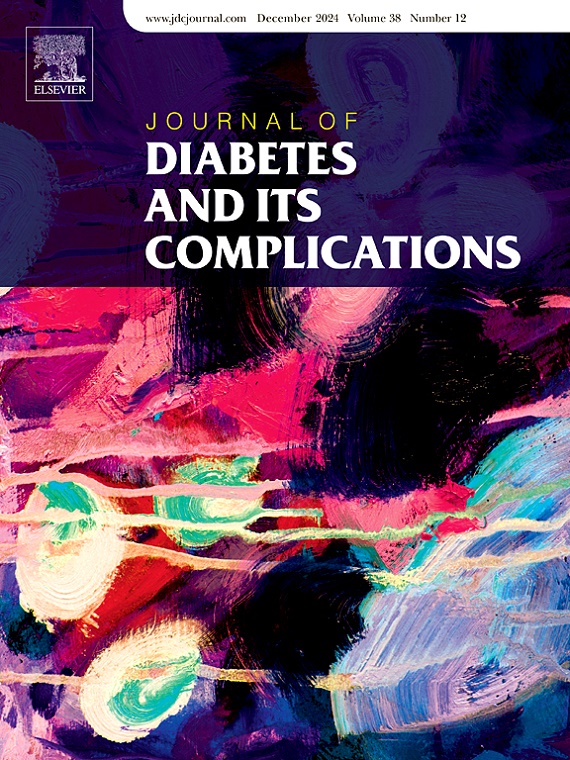因内科以外疾病住院的糖尿病酮症酸中毒 (DKA) 患者的临床特征和预后。
IF 2.9
3区 医学
Q3 ENDOCRINOLOGY & METABOLISM
引用次数: 0
摘要
目的:评估因内科以外疾病而住院的 DKA 患者的临床特征和预后:方法: 对以色列一家三级医院 2005 年至 2022 年期间因 DKA 入院的成年患者进行回顾性分析。将 DKA 患者分为内科组和非内科组,主要结果是院内死亡率:研究共纳入 429 名患者,其中 385 名患者(89.7%)由内科团队治疗,44 名患者(10.3%)因外科或产科疾病住院。非内科组患者的年龄更大(52 ± 18.9 vs 43.6 ± 20.4,P 结论:非内科组患者的年龄更大(52 ± 18.9 vs 43.6 ± 20.4,P 结论):DKA 是一种普遍病理现象,涉及各个医疗领域。每位临床医生都必须熟悉这一病症。因内科以外的疾病住院而被诊断为 DKA 的患者可能是高危人群,其血糖水平可能较低。未来需要开展研究,以确定 DKA 患者亚群的独特特征。本文章由计算机程序翻译,如有差异,请以英文原文为准。
Clinical features and outcomes of patients diagnosed with diabetic ketoacidosis (DKA) who were hospitalized for conditions outside of internal medicine
Aims
To assess the clinical features and outcomes of patients diagnosed with DKA who were hospitalized for conditions outside of internal medicine.
Methods
Retrospective analysis of admissions for DKA in adult patients between 2005 and 2022 at a tertiary hospital in Israel. Patients with DKA were stratified into medical vs non-medical groups, the primary outcome was in-hospital mortality.
Results
429 patients were included in the study, 385 patients (89.7 %) were treated by an internal medicine team, while 44 patients (10.3 %) were hospitalized with surgical or obstetrical conditions. Patients in the non-internal medicine group were older (52 ± 18.9 vs 43.6 ± 20.4, p < 0.005) and had higher rates of diabetes complications such as chronic ischemic heart disease (20.5 % vs. 4.2 %, p < 0.0001) and chronic kidney disease (50 % vs. 3.4 %, p < 0.001). Glucose level on presentation was lower for non-internal medicine patients (398 ± 221 mg/dL vs 551 ± 180 mg/dL) and outcomes of mechanical ventilation and length of hospitalization were more severe (29.5 % vs. 6 %, p < 0.001 and 8.0 vs. 3.0, p < 0.001). Multivariate analysis demonstrated that composite outcome of in-hospital mortality, ICU admission and longer hospitalization was more likely in the non-internal medicine group (OR 3.99, CI 1.89–8.4, p < 0.001).
Conclusion
DKA is a universal pathology that concerns various medical fields. It is essential for every clinician to be familiar with this condition. Patients diagnosed with DKA who were hospitalized for conditions outside of internal medicine may be at high risk and may present with lower glycemic levels. Future research is needed to characterize the unique features of subgroups of patients with DKA.
求助全文
通过发布文献求助,成功后即可免费获取论文全文。
去求助
来源期刊

Journal of diabetes and its complications
医学-内分泌学与代谢
CiteScore
5.90
自引率
3.30%
发文量
153
审稿时长
16 days
期刊介绍:
Journal of Diabetes and Its Complications (JDC) is a journal for health care practitioners and researchers, that publishes original research about the pathogenesis, diagnosis and management of diabetes mellitus and its complications. JDC also publishes articles on physiological and molecular aspects of glucose homeostasis.
The primary purpose of JDC is to act as a source of information usable by diabetes practitioners and researchers to increase their knowledge about mechanisms of diabetes and complications development, and promote better management of people with diabetes who are at risk for those complications.
Manuscripts submitted to JDC can report any aspect of basic, translational or clinical research as well as epidemiology. Topics can range broadly from early prediabetes to late-stage complicated diabetes. Topics relevant to basic/translational reports include pancreatic islet dysfunction and insulin resistance, altered adipose tissue function in diabetes, altered neuronal control of glucose homeostasis and mechanisms of drug action. Topics relevant to diabetic complications include diabetic retinopathy, neuropathy and nephropathy; peripheral vascular disease and coronary heart disease; gastrointestinal disorders, renal failure and impotence; and hypertension and hyperlipidemia.
 求助内容:
求助内容: 应助结果提醒方式:
应助结果提醒方式:


